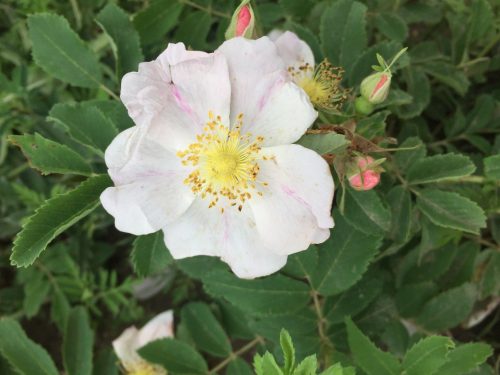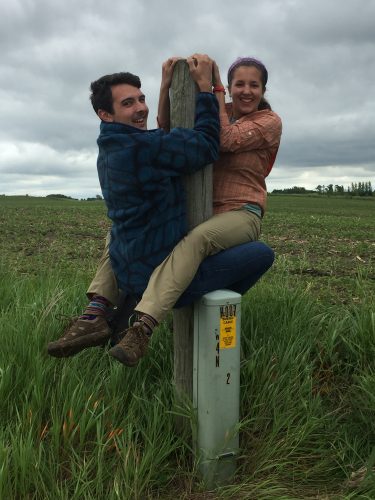Today, we (Alex and Laura) visited the Landfill remnant prairie site and saw some pretty cool stuff. This site is unique because of its long and narrow shape along Sandy Hill road, and because of its shared border with a soy bean field and the local landfill! Luckily, the wind was not blowing toward us and all we could smell were the sweet prairie roses.

A prairie rose (and buds) spotted on the side of Sandy Hill Road.
We believe that this site’s unique fragmentation makes it a good plot for The Echinacea Project. This area still has native prairie plants likely including Echinacea later in the season.
We observed three of the four main types of prairie plants. Most abundant was the non-native, cool season grass, brome. This was really the only grass we saw, and there were no warm season grasses visible. Along the road there was a profusion of prairie roses. We did not see this forb deeper into the fragment, which was interesting and puzzling because in other locations that we visited this week, prairie roses were found throughout the plots. Unlike the prairie rose, another forb, white sage was only found in the interior of the site past the ditch along the road, and was sprinkled with milkweed. Among the white sage, we found a lone false sunflower. It was likely disgruntled because, not only was it lonely, but the sun was nowhere to be found. We also spotted legumes, such as alfalfa and sweet clover, who were much less lonely and basking in the glory of their opulence.

A view of the landfill prairie fragment and its various plants along Sandy Hill Road. (landfill visible in top left corner)
When we visit sites and identify plants, seasoned members of Team Echinacea can predict how this fragment got this way and why these specific plants are present. Today we tried our hand at this game. Considering that the most abundant grass was brome, we believe that this area (the soy bean field and landfill included) was used as land to feed livestock, as brome was initially imported to the New World as fodder for bovine and other grazing creatures. When the agricultural field and landfill were added to this area, the grass persisted in the undisturbed areas. Brome is a nonnative grass that could easily thrive in this area and bounce back from disturbances. Other nonnative plants include alfalfa and sweet clover, which could both thrive in this area for similar reasons. Native plants seem to be lacking at this site, which we attributed to the take over from the grass and legumes and the limited space with strange features. A few native plants, the prairie rose and white sage, were plentiful. They must have persisted through disturbances and been more capable of bouncing back and coexisting with nonnative species than other native prairie plants. We could not account for why all the prairie roses were lined up along the road, but we hypothesized that they were trying to hitch hike to Pasadena for a viewing of the Rose Bowl. Or perhaps, they are just trying to get a ride away form the landfill.
All together, a fun day of developing new skills and strengthening old ones.

Alex and Laura refusing to leave our new favorite site (and also getting splinters).

Leave a Reply